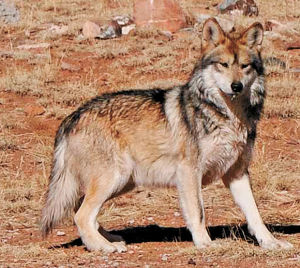Posted: Tuesday, January 14, 2014 5:00 am
In the final month of 2013, a Mexican gray wolf was found shot to
death in New Mexico. The adult male wolf had separated from the
Bluestem Pack in May and wandered outside of the Blue Range Wolf
Recovery Area.A collared wolf, an immature female, was listed as whereabouts unknown in December. She had been observed traveling with another immature female for several months, separated from their home pack, the Fox Mountain Pack in the Gila National Forest. The second female was located outside the Blue Range Wolf Recovery Area in November.
Earlier in the year, a mature female wolf was found shot to death and her pups were not found. She had been living near where she was released in the Gila Wilderness near McKenna Park. She had dispersed from her denning area a few weeks after having pups and was shot on private land. The investigation of the shooting was conducted by Fish and Wildlife Service, New Mexico Game and Fish and Wildlife Services. While conducting the investigation, a cow with bite marks was found and it was determined the attack occurred on private land. “After a comprehensive and thorough investigation” Fish and Wildlife ruled that the wolf was killed legally and the shooting was not in violation of the Endangered Species Act. This was the end of the Halfmoon Pack.
Another mature female wolf died, Aug. 18, after being trapped by the reintroduction project’s Interagency Field Team. The field team had trapped her to replace her radio telemetry collar.
In September, an un-collared wolf was found dead, the cause of death was not immediately identified.
Two packs may be involved in a turf battle in New Mexico. The five collared members of the San Mateo Pack and the two collared members of the Fox Mountain Pack continued to “interact.” (In November there were eight wolves seen traveling with the Fox Mountain Pack.)
The Fox Mountain Pack was making incursions on the San Mateo’s territory, south of Quemado in November and December. The San Mateo’s range is about 210 square miles.
There have been some recent problems with the livestock depredation by the members of the Fox Mountain Pack. The pack was blamed for the deaths of two calves 40 miles southeast of Springerville, near Toriette, New Mexico. On Nov. 21 one of the Fox Mountain Pack members was captured and placed in captivity – the result of a permanent removal order. The Fox Mountain Pack’s territory is about 167 square miles, southwest of Quemado to the Arizona border.
U.S. Fish and Wildlife had also issued a permanent removal order in November for a second male wolf with the Fox Mountain Pack, the status of that order was not mentioned in the December report but the adult male wolf was still listed as a member of the Fox Mountain Pack.
Since September there has a been a permanent removal order out for a an adult female wolf, the sole collared survivor of the Paradise Pack. That order has been extended to Feb. 4. If the alpha female of the Paradise Pack is captured that will be the last known member of the pack. The Paradise Pack’s home range is west of Springerville, near Vernon. The alpha female had been seen traveling with an adult male wolf that left the San Mateo Pack.
A trapper caught an un-collared wolf east of Reserve, New Mexico. The field team collared and gave the wolf an ID number. It is presumed that the wolf is a member of the Luna Pack which had five collared members before the addition of the newly collared immature male.
The population of collared wolves (although it went up and down a little through the year) declined by one in 2013. In its December monthly update, the field team reported that the population of Mexican wolves was 46 (with functioning radio collars) in 13 packs and five lone wolves. At the end January the population was 46 wolves with functional radio collars in 14 packs and four single wolves. One population peak came in April when the field team reported 49 collared wolves, 15 packs and five single wolves. There were no livestock deaths attributed to wolves in December.
During 2013, the deaths of 46 cows were investigated as possible wolf kills. It was determined that 28 cows were killed by wolves, 10 died from unknown causes and eight others died from known causes other than wolves, including lightning strikes, one killed by a bear and one from a gunshot.
The information in this report comes from monthly summaries of Mexican Wolf Reintroduction Project (Project) activities in Arizona on the Apache-Sitgreaves National Forests (ASNF) and Fort Apache Indian Reservation (FAIR) and in New Mexico on the Apache National Forest (ANF) and Gila National Forest (GNF). Non-tribal lands involved in this Project are collectively known as the Blue Range Wolf Recovery Area (BRWRA). Additional Project information can be obtained by calling (928) 339-4329 or toll free at (888) 459-9653, or by visiting the Arizona Game and Fish Department website at www.azgfd.gov/wolf or by visiting the U.S. Fish and Wildlife Service website at www.fws.gov/southwest/es/mexicanwolf.
Past updates may be viewed on either website, or interested parties may sign up to receive this update electronically by visiting www.azgfd.gov/signup.
The Reintroduction Project is a multi-agency cooperative effort among the Arizona Game and Fish Department (AGFD), USDA Forest Service (USFS), USDA-Animal and Plant Health Inspection Service, Wildlife Services (USDA-APHIS WS), U.S. Fish and Wildlife Service (USFWS) and the White Mountain Apache Tribe (WMAT).
To view weekly wolf telemetry flight location information or the 3-month wolf distribution map, please visit www.azgfd.gov/w_c/es/wolf_reintroduction.shtml. On the home page, go to the “Wolf Location Information” heading on the right side of the page near the top and scroll to the specific location information you seek.
source


No comments:
Post a Comment